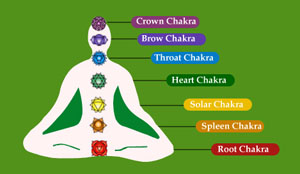A brief background plus an overview of the first three chakras was outlined in part one of the Beginner’s Guide to the Chakras. The following is a continuation of the guide that explains the fourth, fifth, sixth and seventh chakras and what you can do to keep them open and in balance.
4th Chakra
 Sanskrit name: Anahata
Sanskrit name: Anahata
English name: meaning “unstruck”
Location: middle of the chest
Associated body parts: heart, lungs and arms
Color: green
Element: air
Sound vibration: YA
- Governs sense of unconditional love, heart-felt gratitude and the ability to share.
- When your fourth chakra is out of balance you may have difficulty giving and receiving unconditional love for yourself and others. You might also have a weak heart, suffer from arrhythmia, heart palpitations or certain breathing problems.
- Yoga poses such as camel, bow and cobra help to open and balance the heart chakra.
5th Chakra
Sanskrit name: Vishuddha
English name: meaning “purification”
Location: throat
Associated body parts: tonsils, tongue, neck
Color: sky blue
Element: ether
Sound vibration: HAM
- Governs ability to communicate effectively by speaking clearly and listening well to others.
- When your fifth chakra is out of balance you may either talk incessantly, have little patience to listen to others or experience difficulty in getting your point across eloquently. You may also suffer from sore throats, tonsillitis or reoccurring strep throat.
- Yoga poses such as fish pose help to open and balance your throat chakra.
6th Chakra
Sanskrit name: Ajna
English name: meaning “command”
Location: the third eye point in between the eyebrows
Associated body parts: eyes, forehead and frontal lobe of the brain
Color: indigo
Element: light
Sound vibration: OM
- Governs intuition or “sixth sense.”
- When your sixth chakra is out of balance you may experience headaches, confusion, difficulty making decisions and an inability to trust yourself.
- Yoga poses such as seated meditation and child’s pose help to open and balance your sixth chakra.
7th Chakra
Sanskrit name: Sahasrara
English name: meaning “thousand”
Location: crown of the head
Associated body parts: top of the head, pineal gland and mind
Color: Violet
Element: thought
Sound: internal and silent OM
- Governs sense of feeling connected to a higher power or universal consciousness.
- When your seventh chakra is out of balance you may fear death and the unknown, have little faith in that which science has not proved and discount spiritual concepts.
- Yoga poses such as headstand help to open and balance your crown chakra.
Also Read:
Wisdom to Wellness Explores the Emotional and Physical Health Connection
